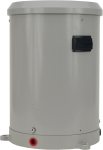
凍結環境下における高強度の降水に最適






概要
HS Hyquest Solutions 社製の CS700H は、8 インチの開口部と頑丈な鋳造アルミニウムベースを備えたヒータ付きのハイエンド転倒マス雨量計です。-20℃までの温度で降雨量を 0.01 インチ単位で測定します。CS700H は、凍結環境下においても激しい降雨が発生する可能性のある場所に最適で、環境モニタリングアプリケーションで使用されます。
続きを読む利点と特徴
- 耐久性と長寿命を実現する超重量金属構造
- 低消費電力
- 高強度降雨をより正確に測定
- 0.01インチ単位の高精度チップ
- 毎時500mmの高降水量で±3%の精度
- ヒータエレメントはバッテリでもAC電源でも動作可能
イメージ



詳細
仕様
| センサタイプ | サイフォンとデュアルリードスイッチを備えたティッピングバケット |
| 測定の不確かさ |
|
| 測定の不確かさ | 700 mm/h (27.6 in./h) 最大 |
| チップあたりの降雨量 | 0.01 in. (0.254 mm) |
| 測定範囲 | 0 ~ 700 mm/h (0 ~ 27.6 in./h) |
| 湿度範囲 | 0 ~ 100% |
| ケーブルタイプ | 2導体シールド |
| 動作温度範囲 |
|
| 出力 | SDI-12 |
| 総消費電流 |
|
| 主電源電圧要件 | 10 ~ 30 Vdc または 12 ~ 28 Vac |
| SDI-12 電源電圧要件 | 9.6 ~ 16 Vdc |
| 排水管サイズ | どちらのフィルタも、内径 12 mm (0.47 インチ) のチューブに対応しています。 |
| オリフィス直径 | 20 cm (7.9 in.) |
| 高さ | 34.2 cm (13.5 in.) |
| 重量 | 3.3 kg (7.4 lb) 7.62-m (25-ft) ケーブル付き |
CS700H-ACオプションのみ |
|
| -注意- | 追加の仕様は、Phoenix Contact の Quint-PS/1AC/24DC/10 のマニュアルに記載されています。 |
| モデル名 | Quint-PS/1AC/24DC/10 |
| AC 入力電圧範囲 | 100 ~ 240 Vac |
| 消費電流 |
|
| 保護回路 | 過渡サージ保護バリスタ |
| 統合入力ヒューズ | 6.3 A (スローブロー、内部) |
| 通常出力電圧 | 24 Vdc ±1% |
互換性
注意: 以下は代表的な互換性情報を示しています。互換性のある製品や互換性のない製品をすべて網羅したリストではありません。
Data Loggers
| 製品 | 互換性 | 注意 |
|---|---|---|
| CR1000 (リタイア) | ||
| CR1000X (リタイア) | ||
| CR300 (リタイア) | ||
| CR3000 (リタイア) | ||
| CR310 | ||
| CR350 | ||
| CR6 | ||
| CR800 (リタイア) | ||
| CR850 (リタイア) |
互換性に関する追加情報
電源に関する考慮事項
CS700H には 2 つの電源構成オプション (AC または DC) があります。AC オプションでは、CS700H に Phoenix Contact 電源が付属します。DC オプションでは、CS700H はユーザー提供のバッテリに接続されます。このオプションは、風力または太陽光発電を使用してバッテリを充電する遠隔地に最適です。必要なバッテリ容量は、アプリケーションとサイトの場所によって異なります。
取り付け
本体のベースは 3 本の脚で支えられています。CM240 レベリングベースとマウント、またはレベリング機能を備えたユーザー提供のベースプレートの使用を推奨します。CM240 は、CM300 シリーズの取り付けポール、またはユーザー提供の 1.5 IPS (外径 1.9 インチ、ねじなし) パイプに取り付けることができます (注文情報を参照)。コンクリート パッドの使用をお勧めします。
ウインドスクリーン
Campbell Scientificは、雨量測定における風の影響を最小限に抑えるために、260-953 ウィンドスクリーンを提供しています。このウィンドスクリーンは、自由に垂れ下がり、風が通過すると揺れる 32 枚の板で構成されています。
ドキュメント
よくある質問
CS700H-Lに関するよくある質問の数: 12
すべて展開すべて折りたたむ
-
これらの雨量計は必ずしも電圧範囲を生成するわけではなく、パルスを生成します。雨量計がデータロガーに接続される方法に応じて、雨量計はソース電流またはシンク電流パルスを生成できます。
-
これらの雨量計はどちらにも接続できます。
- Cポートを使用する場合、1 本のリード線は 5 V ポートに接続されて電流を供給し、もう 1 本のリード線はCポートに接続されて電流を検出します。
- パルス チャネルを使用する場合、1 つのリード線はパルス ポートに接続され、もう 1 つのリード線は接地端子で終了します。
-
- 3 本のネジを外し、ハウジングを上に持ち上げて、ハウジング アセンブリをベースから取り外します。
- 気泡レベルをチェックして、雨量計が水平になっていることを確認します。
- 内側の漏斗から水を注ぎ、2 つのバケツの表面を濡らします。メスシリンダーを使用して、15 分かけて 314 cc (19.16 in3) の水を収集漏斗にゆっくりと注ぎます。この水の量は、降雨量 0.39 インチ (10 mm) に相当します。
- 水が雨量計を通過した後、転倒バケツは TB4-L または CS700-L の場合は 39 回、TB4MM-L の場合は 50 回傾いているはずです。
- 雨量計が正しい転倒回数を記録しない場合は、ユニットを Campbell Scientific に返送して再調整してください。
-
データが正しく記録されていない場合は、次の 2 つの原因が考えられます。
- リードスイッチが故障しました。
- 雨量計からデータロガーへの接続に欠陥があります。これは通常、導体の破損または配線の腐食によって発生します。
-
パルス信号が無い、または重複する。
-
以下を試してみることをおすすめします:
- リード スイッチへの接続がしっかりしていることを確認します。ネジはしっかりと締められ、ワイヤはネジにしっかり接続されている必要があります。
- 現在使用しているリード スイッチからセカンダリ リード スイッチ接続に切り替えてみます。
- ケーブルがデータロガーの正しい入力に接続されていることを確認します。ケーブルのもう一方の端 (センサ側) にある 2 本のワイヤを一緒に触れます。データ ロガーはパルスを受信するはずです。パルスが記録された場合、問題はリード スイッチにあります。リード スイッチを交換します。
- データロガーがまだパルスを受信しない場合は、別のケーブルを使用してみてください。
-
260-953 Alter 型雨量計風防は、自由に垂れ下がり、風が通過すると揺れる 32 枚の重金属の葉で構成されています。揺れる葉は風ダンパーとして機能し、乱流を増やすことなく、雨量測定に対する風の影響を最小限に抑えます。
-
想定以上または以下の雨量でマスが傾く場合です。
-
最も一般的なエラーは、雨量計の校正がずれているように見えるか、またはデータロガーによって雨量計の先端が正しく記録されていないかのいずれかです。
-
CS700H-L には、つららの形成を防ぐための 3 つのヒーター部があります。ヒーターのうち 2 つは漏斗の底にあり、1 つはバケツの底にあります。ヒーターがあるため、このセンサには約 5 A の電源が必要です。センサの SDI-12 インターフェイスは、必要なときだけヒーターがオンになるように制御します。
Privacy Policy Update
We've updated our privacy policy. 詳細はこちら
Cookie Consent
Update your cookie preferences. クッキーの設定を更新する


